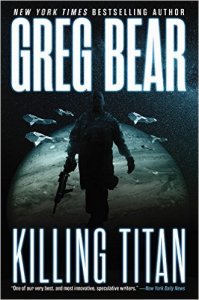Russell Letson reviews Greg Bear
Killing Titan, Greg Bear (Orbit 978-0-316-22400-0, $26.00, 326pp, hc) October 2015.
 I should probably cop to this: I’m fascinated by military history, but I’ve never been much taken by what I think of as genre military SF, by which I mean adventure stories set in the military establishment and emphasizing weaponry, comradeship, chains of command, career progress, and (of course) combat. As much as I enjoyed and understood Starship Troopers and The Forever War, I have found the run of routine combat or military-life series, well, routine and no match for the best of their historical-setting cousins (C.S. Forester, Bernard Cornwell, Patrick O’Brian, George MacDonald Fraser).
I should probably cop to this: I’m fascinated by military history, but I’ve never been much taken by what I think of as genre military SF, by which I mean adventure stories set in the military establishment and emphasizing weaponry, comradeship, chains of command, career progress, and (of course) combat. As much as I enjoyed and understood Starship Troopers and The Forever War, I have found the run of routine combat or military-life series, well, routine and no match for the best of their historical-setting cousins (C.S. Forester, Bernard Cornwell, Patrick O’Brian, George MacDonald Fraser).
The military SF that has caught my attention over the last 25 years generally adds extra ingredients to the military-adventure recipe, for example, the alien-encounter motifs in Eleanor Arnason’s Ring of Swords (1993) and Harry Turtledove’s Worldwar series (1996-). Or various perspective flips, as in the Arnason, which is particularly subversive to the tradition; or Susan R. Matthews’ first Jurisdiction novel, An Exchange of Hostages (1997), which sets up unbearable tensions between duty (or obedience) and decency, honor, and humanity. Or the military material which can be embedded in much larger contexts, such as in Walter Jon Williams’ Dread Empire (2002-03) and Scott Westerfeld’s Succession sequences (2003), which make the military component just one part of sprawling space-opera/interstellar-empire settings – with, in the Williams, an additional dose of novel-of-manners.
Recently I have encountered several more series that place military life and actions in wider social or political or moral-speculative contexts, while still supplying as much shooting and blowing-stuff-up as a fellow could want. Ann Leckie’s Ancillary sequence (reviewed in October 2013, 2014, and 2015), Linda Nagata’s The Red: First Light (reviewed in August 2013, with others coming soon), and Zachary Brown’s The Darkside War (reviewed in July 2015) are what might be called skeptical or severely-qualified military-SF adventures. This is not so much a completely new movement as an extension of the against-the-grain attitude that can be traced back to The Forever War, where the conflict turns out to be based on a misunderstanding, with the added irony that the human society that emerges from the war winds up having a lot in common with that of the former enemy. This new batch of military stories seems to be moving beyond irony, beyond we-made-a-mistake-getting-involved, to questions of the trustworthiness – or just the worthiness – of the power structures being defended by honorable, competent soldiers.
Greg Bear’s currently-running series fits right into this grouping. In the opening volume, War Dogs (reviewed in November 2014), humankind has been drafted into an interstellar conflict between sets of aliens powerful enough to kill planets. One set, the Gurus, present themselves as benefactors before revealing that they have been pursued across interstellar space by their enemies, the Antags. And the Antags, they announce, are already in the solar system, ready to follow their usual program:
the conversion of every planet, every moon, every asteroid, into raw materials out of which Antag engineers would assemble a kind of gigantic clockwork for harnessing the sun’s energy, and then would convert the sun itself – said energy to be shipped thousands of light-years, through means not revealed, to power other solar systems and further promote the conquest of other planets around other suns….
So humankind has to take them on, with the advice and technological backing of the Gurus – though not with their personal, physical assistance. Much of War Dogs consists of flashbacks in which Master Sergeant Vinnie Venn recalls combat on Mars and events centered on the Drifter, a chunk of a fallen moon from the solar system’s very deep history. The Gurus, for reasons known only to themselves, ordered it destroyed, and on his return home from this operation, Venn is quarantined (which feels like imprisonment) and endlessly debriefed (which feels like interrogation) about what he and his surviving fellow Skyrines experienced inside the Drifter.
The crucial action of Killing Titan begins when Venn is broken out of quarantine and returned to Mars with the remnants of his old squad, and then transported to Saturn’s orbit, where the fight is for control of Titan, and where another chunk of billion-year-deep history waits. Some factions on the human side – including some members of the human intermediaries called ‘‘Wait Staff’’ – suspect that the Gurus are not telling us the whole truth about the war or about the Antags, and it is one of these dissident groups that breaks Venn out of detention and sends him to Mars and then Titan-ward. On a more personal level, there’s the matter of what infected Venn and his squadmates while they were in the Drifter. The green powder they called ‘‘Ice Moon Tea’’ carries something far stranger than a disease – Venn finds himself not alone in his head, but host to the persona of a dead comrade and to the memories of creatures that vanished before life evolved on Earth.
Despite the title, Venn and his companions don’t get to Titan until the last ninety pages of the novel. The long middle section details the return to Mars and another Drifter-like object, along with increasingly vivid invasions of Venn’s headspace by ghosts and recollections that don’t come from his own life. Some events from the first book get explained, though the explanations raise as many questions as they answer.
The voyage to Titan is almost dreamlike in a different way, aboard a very exotic, Guru-tech-based spacecraft,
a shiny, curvy, intricate white framework wrapped around long clusters of glowing spheres like Japanese paper lanterns – and surrounding everything else, those shrouds, the bright outer skirts, pleated panels rippling like silk in a slow breeze. It doesn’t look practical, barely looks real.
On board, it’s a mix of the familiar (a gruff ‘‘go bitch’’ – crew chief – who ‘‘looks like a former beauty queen who’s spent too many years under the Texas sun’’ and calls herself Bueller) and the strange and unsettling, starting with a pre-launch prep called a quantum purge, required because ‘‘Downsun, you’ve been hanging with bad company since before you were born. Pasts that never were, futures that will never be. They slow you down.’’ Clearly Guru space-drives involve more than great big rocket motors, and one suspects that quantum-y stuff is going to figure in other ways as well.
After this much setup, the Titan section has some serious expectations to live to, and it does not disappoint, with both vivid planetology and traditional mil-SF attention to exotic-environment combat gear and operations. Add a cliffhanger ending and the promise of continuing, possibly cosmic vastening of the meta-story, and you have as strong a mid-trilogy volume as you could want.




thanks, beautifully written. I just finished Greg’s Eternity. Like Greg I was born 1951. The Eon trilogy and especially made perfect sense to me. However I also write a lot.
Eternity reminded me of late Larry Niven where he is primarily imagining, having an inner experience, reporting each chapter like a snapshot from a much bigger imagination. Eternity seems to em to be a writer writing about writing too.
I do understand why some readers find Erternity slow. It’s almost free of familiar sci-fi tropes. If you want those, Eternity is not your book.